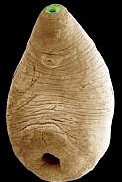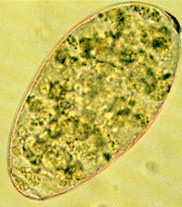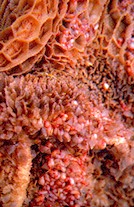Paramphistomum is a genus of flukes belonging to the trematode flatworms. They infect cattle, sheep, goats and other livestock as well as a number of wild ruminants.They are found worldwide, especially in humid regions, with varying prevalence depending on climatic and ecologic conditions. In endemic regions prevalence can be very high, up to 80% of the animals in a herd can be infected.
The most frequent species in temperate regions (e.g. in Europe) is Paramphistomum cervi. In tropical and subtropical regions species of other related genura (e.g. Cotylophoron, Calicophoron and Gigantocotyle) are predominant.

Paramphistomum flukes are also called rumen flukes or stomach flukes.
These flukes do not affect dogs, cats or poultry.
The disease caused by Paramphistomum is called paramphistomiasis (or amphystomosis).
Are animals infected with Paramphistomum flukes contagious for humans?
NO. If livestock is infected with stomach flukes, they are not contagious for humans, neither through contact, nor after consuming meat, milk or blood of contaminated animals. The same applies to pets. The reason is that Paramphistomum species are not parasitic for humans. Human paramphistomiasis is caused by other related stomach flukes, e.g. Gastrodiscoides hominis in Asia and Watsonius watsoni in Africa.
You can find additional information in this site on the general biology of parasitic worms and/or flukes.
Final location of Paramphistomum spp
Predilection site of adult Paramphistomum flukes is the stomach; immature flukes congregate in the small intestine (duodenum and jejunum).
Anatomy of Paramphistomum spp
Rumen flukes are rather small, not longer than 1.5 cm and 0.5 cm wide. The have a grayish to reddish color. Unlike many fluke species their body is not flattened but pear-shaped, with the head at the narrowest end. The cross section is almost cylindrical. They have two suckers, an oral and a ventral one, the latter much larger and close to the posterior end.
As other flukes, they have no external signs of segmentation. The mouth ends in the pharynx, a muscular tube that allows sucking. The digestive system is blind (i.e. without exit: the only opening is the mouth) and not linear, as in most animals, but branched, ending in several blind ducts (called coeca). As most flukes, rumen flukes are simultaneous hermaphrodites, i.e. they have both male and female reproductive organs.
The eggs are operculated (~130x80 micrometers), very similar to those of Fasciola hepatica but slightly lighter.
Life cycle and biology of Paramphistomum spp

Paramphistomum have an indirect life cycle with freshwater snails as the intermediate hosts, e.g. of the genus Bulinus, Planorbis, Stagnicola, etc.
Adult flukes in the stomach lay eggs that are shed outside with the feces. About 2 weeks later miracidia hatch out of the eggs. They swim in the water until they find a suitable snail. They penetrate into the snail and continue development to sporocysts and rediae, which can multiply asexually and produce daughter rediae. Each redia produces several cercariae, the next developmental stage. Out of a single miracidium up to 30 cercariae can develop.
Cercariae abandon the snail, swim around and attach to the vegetation where they encyst and become metacercariae, which are infective for final hosts that feed on infested vegetation. Encysted metacercariae do not survive dryness, but can survive and remain infective for up to 1 year in a humid and temperate environment, and are capable of overwintering.
Livestock ingests metacercariae while grazing in contaminated pastures. Once in the small intestine the young flukes leave the cysts, attach to the intestinal mucosa and continue development. They feed on the tissues of the gut wall. Later on they detach from the gut's wall and migrate to the rumen, where they complete development to adult flukes and start producing eggs. After ingestion by the final host it takes 2 to 4 months for metacercariae to complete development and start laying eggs (pre-patent period).
Harm caused by Paramphistomum, symptoms and diagnosis
The adult flukes in the stomach are usually not very harmful, despite the high numbers that can congregate there. However, masses of young flukes attaching to the gut wall and feeding on it are very harmful. Such young flukes destroy the gut tissue, including its glands and adjacent lymph nodules. This disturbs digestion and the immune system. Young animals and those sick or otherwise weakened are more susceptible to be harmed by rumen flukes. Fatalities can't be excluded.
The major clinical sign of stomach fluke infection is enteritis (inflammation of the small intestine) and strong diarrhea (watery scour) with blood traces, and as a consequence dehydration, dullness, weight loss, etc. Anemia and bottle jaw can also develop.
Diagnosis requires fecal examination, which can reveal either eggs (not easy to distinguish from Fasciola hepatica eggs) or young flukes. A history of Paramphistomum infections in the region supports the diagnosis.
Prevention and control of Paramphistomum

Where rumen flukes are endemic, preventive measures are a must to reduce the snail populations, the infection of pastures with infective stages, or the access to livestock to highly infested pastures.
Vector snails are aquatic and live in water (e.g. streams, lakes, pools, swamps, marshes, irrigation channels, ditches, ponds, watering holes, waterlogging, etc.) and are enormously prolific. Whatever measures help keeping the pastures dry have to be encouraged, either to reduce the snail population, or to shorten survival of encysted metacercariae, e.g.:
- Ensuring an adequate drainage
- Building watering points on solid ground, without puddles
- Make unavoidable ditches or channels less attractive to the snails: making the borders steeper and/or cover them with concrete, eliminate the surrounding vegetation, drying them completely out periodically, etc.
- Avoid even very small water points that support the snails, e.g. hardened footprints (of shoes or car tires).
If permanent humid environments cannot be eliminated, they have to be fenced to prevent livestock from grazing there.
natural immunity that will make them more resistant to massive attacks by young flukes.
Keeping livestock healthy and well fed diminishes the harm caused by rumen flukes and favors the development of the previously mentioned natural immunity.
There are so far no vaccines against rumen flukes. To learn more about vaccines against parasites of livestock and pets click here.
Biological control of rumen flukes (i.e. using their natural enemies) is so far not feasible.
You may be interested in an article in this site on medicinal plants against external and internal parasites.
Chemical control of Paramphistomum infections
Active ingredients with confirmed efficacy against rumen flukes are mainly:
- Oxyclozanide (salicylanilide), narrow-spectrum flukicide.
- Niclosamide (salicylanilide), medium-spectrum anthelmintic. Effective only against immature rumen flukes, not against adults. Effective also against several tapeworms. Also a molluscicide (snail killer)
In most countries there are not too many commercial brands (a few drenches) for livestock with these active ingredients, if ever.
Some older flukicides (e.g. resorantel, hexachlorophene) had efficacy against rumen flukes too, but have been vastly abandoned.
Many other classic flukicides do not control rumen flukes, e.g. albendazole, clorsulon, netobimin, nitroxinil and triclabendazole. Neither macrocyclic lactones (e.g. ivermectin) nor levamisole are effective against any kind of flukes either.
Chemical control of the snails with molluscicides (i.e. snail killers) such as copper sulphate, sodium pentachlorophenate, niclosamide, etc. can make sense for very specific purposes, e.g. for treating places where livestock congregates (water holes, feeding areas, salt licks, shade trees, etc) to keep them free of snails. However, trying to eradicate snails from a property is hopeless and useless.
It is virtually impossible to treat every place where they can survive and they reproduce extremely quickly. Cleaned pastures would become re-infested very fast. In addition, it would be too expensive and very harmful for the environment. In fact, such molluscicides are not approved in most countries.
|
Ask your veterinary doctor! If available, follow more specific national or regional recommendations or regulations for rumen fluke control. |
Resistance of Paramphistomum to flukicides
So far there are no reports on resistance of rumen flukes to flukicides.
This means that if a flukicide fails to achieve the expected efficacy, chance is very high that it is not due to resistance. Either the product was used incorrectly or it was unsuited for the control of rumen flukes. Incorrect use is the most frequent reason for failure of antiparasitic drugs.